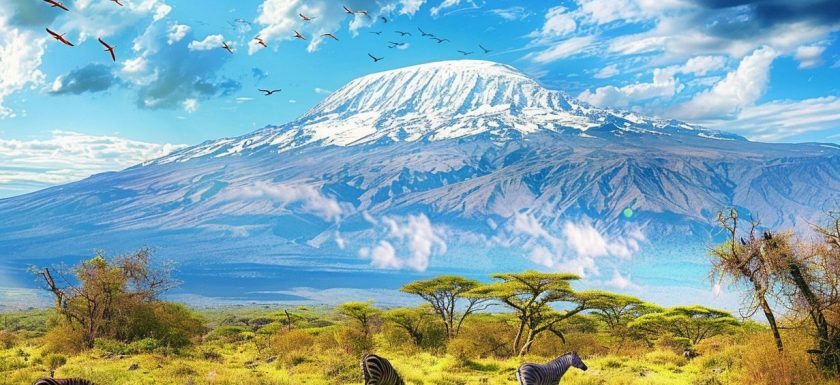
If you’ve ever dreamed of encountering majestic wildlife in their natural habitat, look no further than Kilimanjaro. From African elephants to elusive leopards, this iconic mountain is home to a diverse array of animals.
Discover how these creatures survive in challenging conditions, the threats they face, conservation efforts, and tips for spotting these incredible animals in the wild.
Key Takeaways:
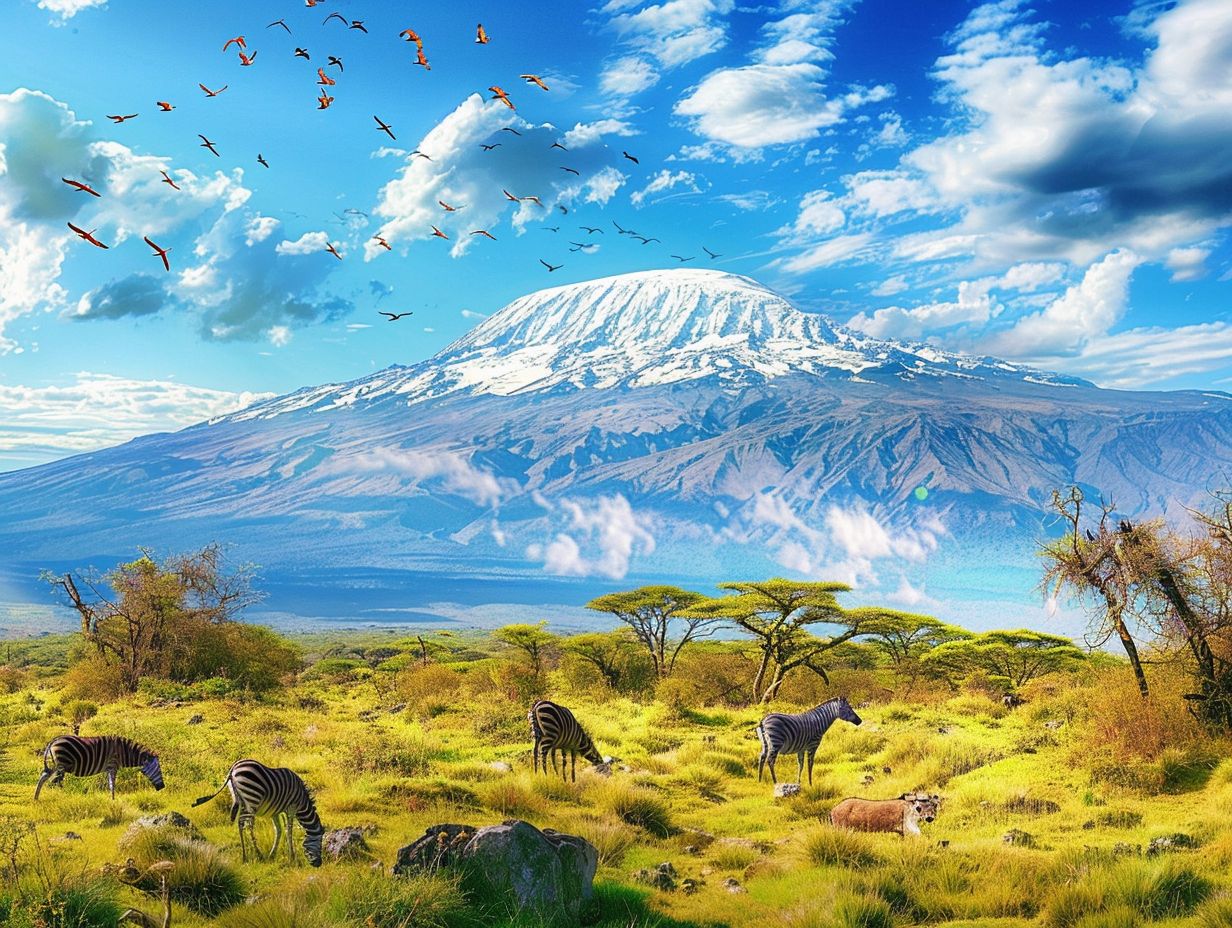
- Animals on Kilimanjaro have adapted to high altitude and harsh conditions, including African elephants, leopards, and colobus monkeys.
- Survival for animals on Kilimanjaro means finding ways to access food and water, such as through specialized adaptations and migration patterns.
- Threats to animals on Kilimanjaro include human activity, climate change, and habitat loss, highlighting the need for conservation efforts to protect their diverse wildlife.
What Animals Can Be Found on Kilimanjaro?
Kilimanjaro, located in Tanzania, is home to a diverse array of wildlife, including African Elephants, Leopards, Buffaloes, Colobus Monkeys, Olive Baboons, Bushbucks, Red Duikers, and a variety of bird species.
Among these diverse wildlife species on Kilimanjaro, the African Elephants are a majestic sight as they traverse the mountain slopes in search of food and water. Leopards, known for their elusive nature, often camouflage themselves in the rocky outcrops, blending seamlessly into the surroundings.
Buffaloes, with their strong herding instincts, can be spotted moving together in harmony across the grasslands. Colobus Monkeys swing gracefully from tree to tree, showcasing their acrobatic skills.
African Elephants
African Elephants, the gentle giants of Kilimanjaro, roam the foothills and lower forested slopes of the mountain, showcasing their majestic presence and social behaviors in the wild.
These iconic creatures play a crucial role in shaping the ecosystem of Kilimanjaro by creating pathways through the dense vegetation, which benefits other wildlife species. Elephants are known for their tight-knit family structures, with matriarchs leading the herds in search of food and water.
Their interactions with various species like buffalos, zebras, and giraffes contribute to the delicate balance of the region, demonstrating the interconnectedness of nature.
Despite their significance, African Elephants face threats from poaching and habitat loss, making conservation efforts vital to protect these majestic giants for future generations.
Leopards
Leopards, the elusive big cats of Kilimanjaro, blend seamlessly into the mountainous terrain, showcasing their stealth and hunting prowess in this unique ecosystem.
These magnificent predators are skilled stalkers, using their exceptional camouflage to ambush prey such as antelope and small mammals. Their methodical approach involves patiently waiting for the perfect moment to strike with lightning speed, ensuring a successful hunt. Leopards also display remarkable agility, effortlessly navigating the rocky outcrops and dense vegetation of Kilimanjaro.
In terms of habitat preferences, leopards favor areas with diverse vegetation cover that offer both ample hiding spots and open spaces for hunting. They are known to adapt to various altitudes, from lower slopes to higher elevations, showcasing their versatility.
These majestic felines face numerous conservation challenges, including habitat loss due to human encroachment and poaching for their valuable skins. Conservation efforts are crucial to protect the leopard population on Kilimanjaro and maintain the delicate ecological balance.
Despite the challenges, leopards play a vital role in controlling herbivore populations, helping to regulate the ecosystem’s balance. Their interactions with other wildlife, including competition with hyenas and occasional conflicts with lions, add complexity to the intricate web of relationships within the Kilimanjaro region.
Buffaloes
Buffaloes, known for their formidable presence on Kilimanjaro, roam the savannah and grasslands near the mountain, forming herds that exemplify strength and unity in the face of predators.
These magnificent creatures display a complex social structure within their herds, where individuals communicate through various vocalizations and body language to maintain cohesion. Buffaloes are primarily herbivores, grazing on a variety of grasses and plants that dot the landscape, contributing to the ecosystem’s delicate balance.
Their grazing patterns often influence the distribution of vegetation, impacting the availability of resources for other herbivores in the region. Their interactions with species like zebras and wildebeests create intricate dynamics within the local wildlife community.
Colobus Monkeys
Colobus Monkeys, with their striking black-and-white fur, swing through the treetops of Kilimanjaro, showcasing their acrobatic skills and social behaviors within the forested habitats.
These primates have a unique feature among monkeys – they lack thumbs, which helps them move swiftly through the canopy. In their social structures, Colobus Monkeys live in large groups, often composed of several males, females, and their offspring.
Their diet primarily consists of leaves, fruits, seeds, and occasionally insects, making them important seed dispersers in the ecosystem.
Interactions with other primate species on Kilimanjaro are fascinating to observe. They share habitats with vervet monkeys, baboons, and galagos, each occupying distinct ecological niches. Colobus Monkeys play a crucial role in maintaining the balance of the forest ecosystem through their feeding habits and interactions with other species.
Olive Baboons
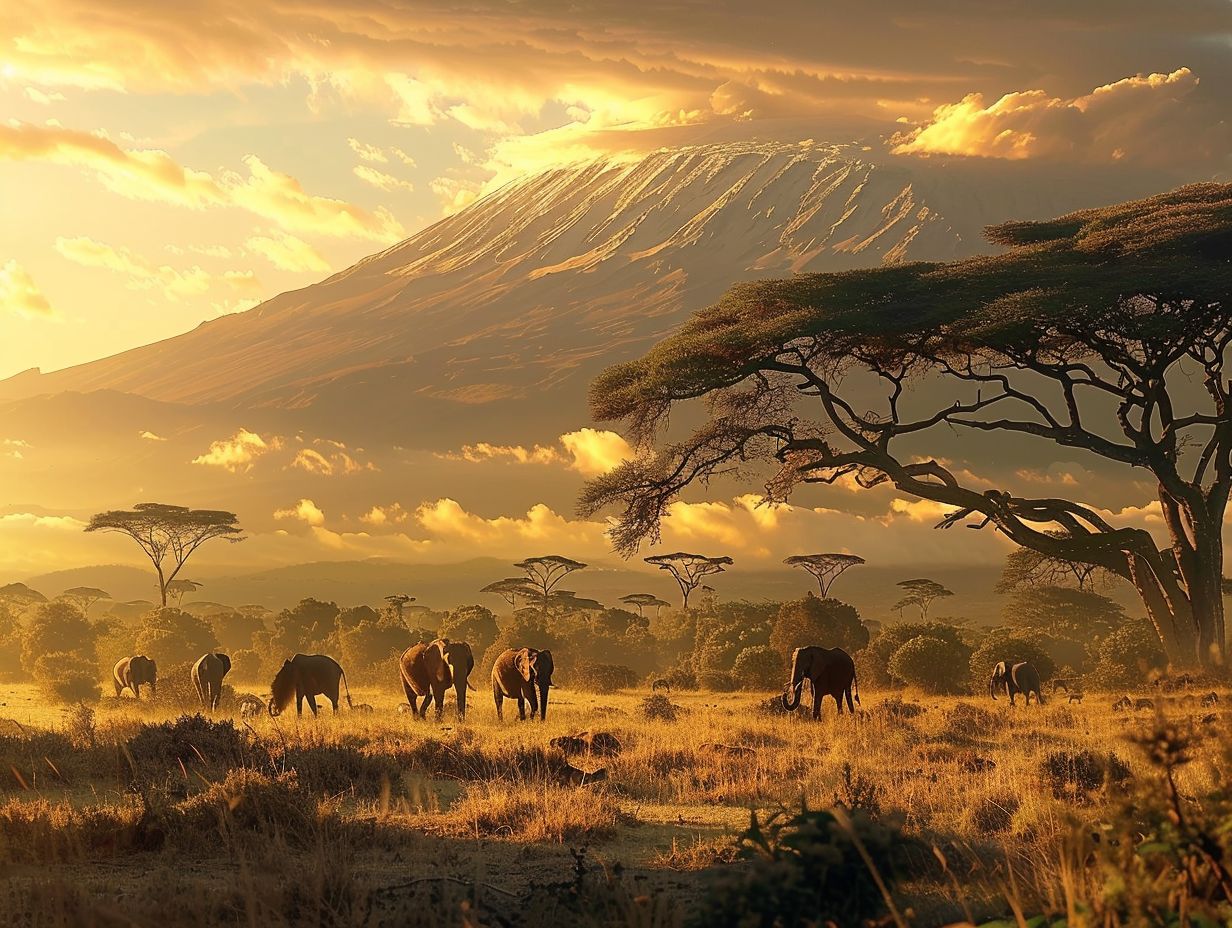
Olive Baboons, the charismatic primates of Kilimanjaro, traverse the rocky outcrops and cliffs, displaying their intelligence and social hierarchy in the wild.
These baboons live in complex hierarchical societies led by dominant males, who play a crucial role in decision-making and protecting the troop. Their communication methods include vocalizations, facial expressions, and grooming rituals, which reinforce social bonds within the group.
When foraging for food, Olive Baboons show remarkable adaptability, utilizing their keen observational skills to locate edible plants, seeds, and insects in the mountain’s diverse ecosystem. They also interact with other wildlife species like elephants and buffaloes, demonstrating both cooperation and competition in their shared habitat.
Bushbucks
Bushbucks, the graceful antelopes of Kilimanjaro, navigate the dense undergrowth with agility and elegance, showcasing their territorial behaviors and natural camouflage.
Feeding habits of bushbucks vary, as they are primarily browsers, feeding on leaves, fruits, and succulent plants. They can adapt their diet according to the seasonal availability of food in the montane forests and savannas they inhabit.
Mating rituals involve elaborate displays by males, marking their territory with scent markings and engaging in vocalizations and sparring to attract females.
Anti-predator adaptations in bushbucks include their keen senses of sight, smell, and hearing, allowing them to detect potential threats early. Their ability to blend into their surroundings through cryptic coloration helps them evade predators such as leopards and wild dogs.
Red Duikers
Red Duikers, the elusive antelopes of Kilimanjaro, dart through the dense vegetation, showcasing their shy nature and exceptional agility in evading predators.
These small antelopes have a preference for dense brush and thickets, providing them with cover and protection from predators such as leopards and pythons. They are primarily crepuscular, being most active during dawn and dusk, when they forage for a variety of vegetation including leaves, fruits, and buds.
During the mating season, male Red Duikers establish territories and compete for females through displays of dominance and scent marking. Mating pairs stay together temporarily before parting ways, with the female typically giving birth to a single offspring.
Survival for Red Duikers in the ecosystems of Kilimanjaro is challenging due to habitat loss from deforestation and human encroachment. They play a crucial role in the local biodiversity by shaping plant communities through their browsing habits. Conservation efforts are vital to protect these unique antelopes and maintain the ecological balance in the region.
Birds
Birds of various species and colors grace the skies and forests of Kilimanjaro, filling the air with melodies and vibrant plumage that add to the natural beauty of the mountain.
These avian creatures bring life to the ecosystem through their unique behaviors and characteristics. From the majestic African Fish Eagle soaring over the treetops to the tiny Sunbirds delicately sipping nectar from flowers, each species plays a vital role in maintaining the delicate balance of the region.
Nesting behaviors vary among birds, with some building intricate nests high in the canopy, while others prefer the safety of tree hollows. During the breeding season, the mountain echoes with the chirps and calls of feathered parents caring for their young.
How Do Animals Survive on Kilimanjaro?
Animals on Kilimanjaro have evolved unique adaptations to survive in the diverse habitats and challenging altitudes of the mountain, exhibiting behaviors and characteristics that enable them to thrive in this extraordinary ecosystem.
Some of the most fascinating adaptations can be observed in the mountain’s high-altitude zones, where temperatures drop drastically and oxygen levels are low.
Mountain goats, for instance, have specialized cloven hooves that provide them with excellent traction on steep rocky slopes, allowing them to navigate the rugged terrain with ease.
In contrast, the elusive leopard has adapted with thick fur to combat the cold, utilizing its exceptional climbing skills to hunt in these harsh conditions.
Adaptations to High Altitude
Animals on Kilimanjaro have developed remarkable physiological and behavioral adaptations to cope with the thin air, low oxygen levels, and temperature fluctuations at high altitudes, ensuring their survival in this extreme environment.
Mammals such as the elusive leopard and the agile klipspringer have evolved thicker fur and specialized breathing mechanisms to thrive in the cold, oxygen-deprived upper slopes of the mountain.
Birds like the iconic lammergeier and the tawny eagle soar effortlessly through the skies, their wings perfectly adapted for efficient gliding in the thin air.
High-altitude reptiles such as the endemic Kilimanjaro spitting cobra have developed heat-absorbing dark scales to regulate body temperature in the chilly mountain climate, while insects like the famous Kilimanjaro golden-winged sunbird have adapted to sip nectar from high-altitude flowers to sustain themselves in this unique ecosystem.
Finding Water and Food
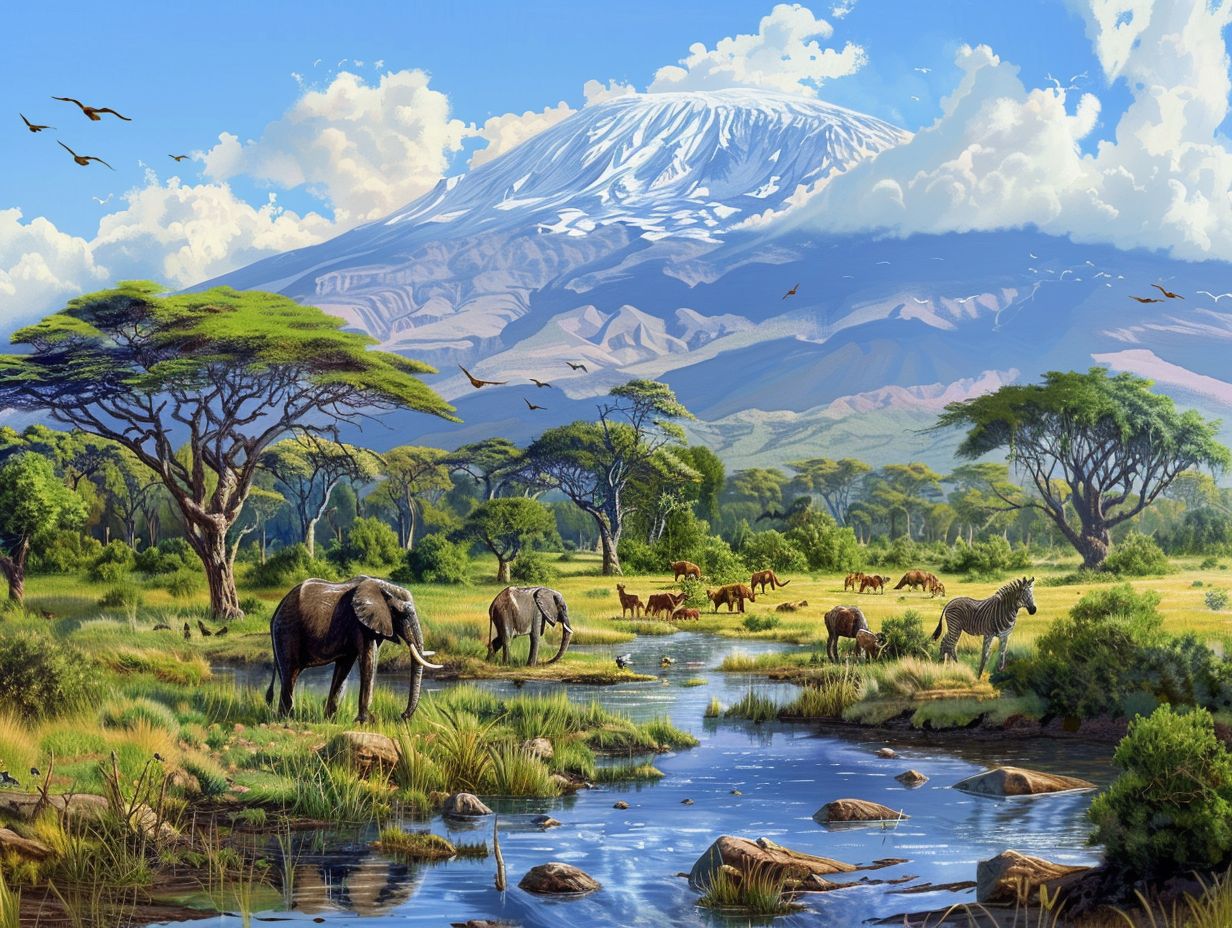
In the diverse habitats of Kilimanjaro, animals employ a range of strategies to find water sources and forage for food, adapting their behaviors and movements to the seasonal changes and availability of resources on the mountain.
At lower altitudes, where streams and rivers meander through lush forests, animals like elephants, buffaloes, and various primates rely on these accessible water sources for hydration. The dense vegetation provides ample foraging opportunities for herbivores such as antelopes and giraffes, who graze on the abundant foliage.
As the landscape transitions to the arid slopes, species like zebras and wildebeests move in search of scattered watering holes and sparse patches of vegetation. Predators like lions and leopards are skilled hunters, stalking their prey through the dry grasslands, utilizing their keen senses to track down their next meal.
The high alpine desert poses a unique challenge, where only certain adapted species like the rare Kilimanjaro shrew can thrive. These resilient creatures have evolved to extract moisture from the air, minimizing their need for traditional water sources.
What Threats Do Animals Face on Kilimanjaro?
Despite their resilience, animals on Kilimanjaro confront significant threats from human activities, climate change, and habitat loss, posing challenges to their survival and the delicate balance of the mountain’s ecosystems.
Human encroachment leads to the destruction of crucial habitats for many species on Kilimanjaro. Deforestation, agriculture, and infrastructure development encroach on the natural territories of wildlife, forcing them to adapt or suffer. Climate change exacerbates these challenges by altering the mountain’s weather patterns, disrupting food sources and migration routes.
For instance, the retreating glaciers affect water availability, impacting animals like the endangered Eastern Mountain Bongo which rely on specific water sources. Habitat destruction disrupts the intricate web of interactions between species, leading to population declines and potential extinctions.
Human Activity
Human activities such as deforestation, poaching, and encroachment into wildlife habitats pose a significant threat to the diverse animal species that call Kilimanjaro home, disrupting ecosystems and endangering vulnerable populations.
Illegal hunting practices have not only depleted the populations of iconic animals like elephants and rhinos but have also disrupted the delicate balance of predator-prey relationships in the region.
Rampant deforestation for agricultural purposes has led to habitat loss for many endemic species, pushing them to the brink of extinction.
The indiscriminate dumping of waste and pollutants has contaminated water sources, affecting the health of both terrestrial and aquatic species.
Climate Change
The effects of climate change, such as shifting temperatures, altered precipitation patterns, and habitat disruption, pose a significant risk to the delicate ecosystems and vulnerable species on Kilimanjaro, necessitating adaptive strategies to safeguard biodiversity.
These changes are particularly impactful on the diverse fauna and flora of the region. For instance, rising temperatures at higher altitudes may force certain species to migrate to cooler areas, disrupting their traditional habitats and food sources.
Alpine species like the Mount Kilimanjaro’s famous elephants, buffaloes, and leopards face challenges in finding suitable grazing grounds, impacting their survival rates.
Altered rainfall patterns can lead to vegetation changes, affecting herbivores’ food availability and thus impacting the entire food chain. Unpredictable weather conditions can also trigger wildfires, adding further stress to already vulnerable ecosystems.
Conservation efforts are crucial in mitigating these impacts. Implementing measures like protected areas, wildlife corridors, and sustainable land use practices are vital to ensuring the long-term survival of the rich biodiversity of Kilimanjaro.
Habitat Loss
The loss of natural habitats due to deforestation, urbanization, and agricultural expansion threatens the biodiversity and ecological balance of Kilimanjaro, reducing available resources for wildlife and increasing human-animal conflicts.
As habitat loss continues to encroach upon the native territories of the diverse species residing on Kilimanjaro, the impacts are far-reaching. It leads to a significant change in the distribution of animals, forcing them to search for new areas to find food and shelter.
This disruption in their primary habitats can result in increased competition among different species for limited resources, ultimately leading to food scarcity and territorial conflicts.
Conservation efforts play a crucial role in safeguarding the biodiversity and ensuring the longevity of the unique ecosystems present on the mountain. Implementing measures such as establishing protected areas, reforestation projects, and promoting sustainable land use practices are vital steps in mitigating habitat destruction and preserving critical habitats for the wildlife on Kilimanjaro.
Conservation Efforts for Kilimanjaro’s Wildlife
Conservation initiatives on Kilimanjaro aim to protect the diverse wildlife species, preserve their habitats, and promote sustainable practices that ensure the long-term survival of endemic and endangered fauna in this iconic mountain region.
These initiatives involve a collaborative effort between local conservation organizations, government agencies, and international partners to implement a range of projects geared towards safeguarding the rich biodiversity of Kilimanjaro.
Through strategic partnerships, such as those with research institutions and community groups, initiatives like habitat restoration programs and wildlife monitoring schemes have been established to track the population trends of key species and mitigate potential threats.
Tips for Viewing Animals on Kilimanjaro
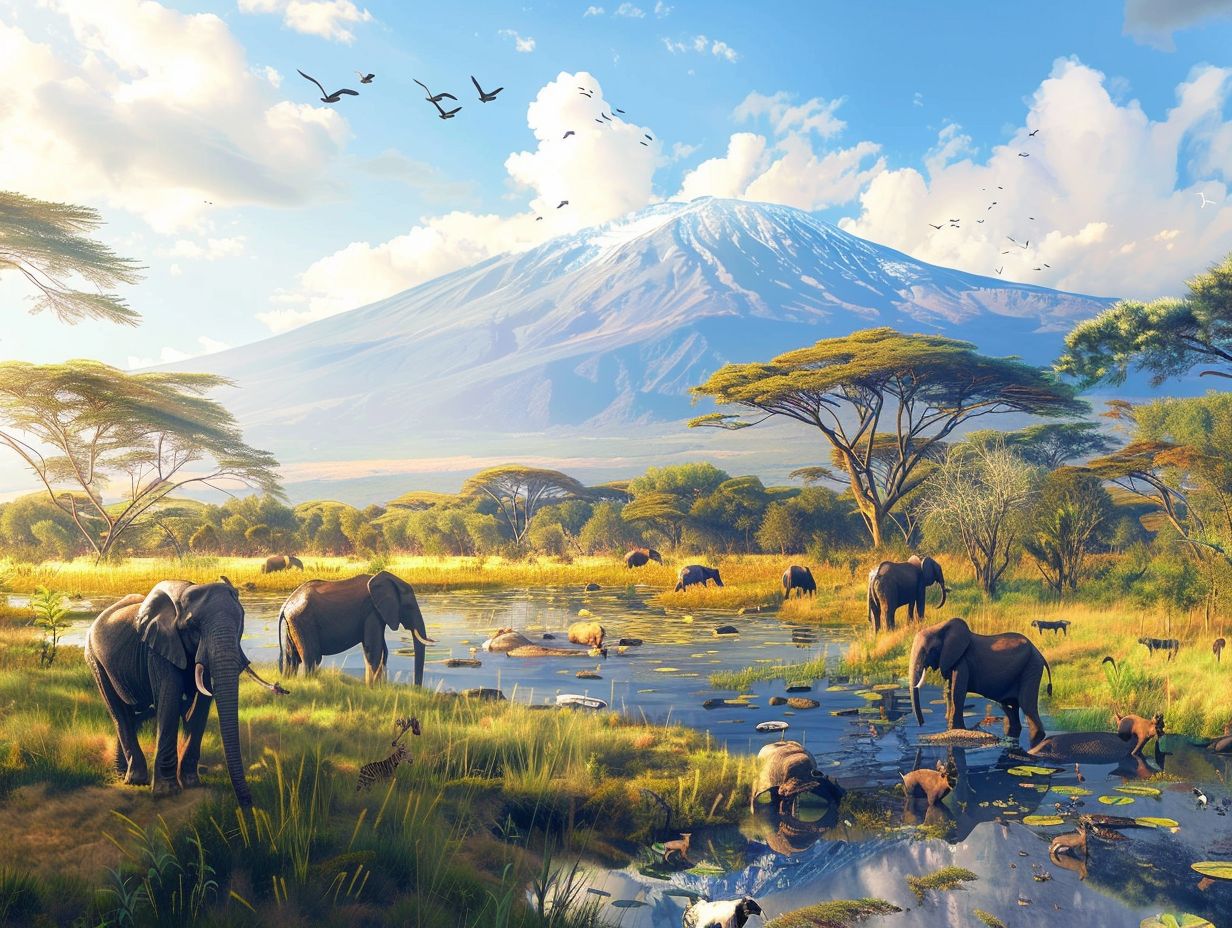
For an unforgettable wildlife viewing experience on Kilimanjaro, consider embarking on guided treks, safaris, or nature walks led by experienced guides who can navigate the diverse habitats and reveal the rare sightings of animals in their natural environment.
To make the most of your wildlife photography opportunities, position yourself strategically at prime viewing locations such as Shira Plateau for elephants, the mountain’s forests for colobus monkeys, or the alpine desert zone for mountain reedbucks.
Early mornings and late afternoons typically offer the best lighting conditions for capturing stunning wildlife moments. Remember to maintain a respectful distance from the animals and avoid disturbing their natural behaviors, as this contributes to the preservation of their habitats on the mountain.
Frequently Asked Questions
What animals can be found on Kilimanjaro?
There are a variety of animals that can be found on Kilimanjaro, including elephants, leopards, buffaloes, and a variety of antelopes.
Are there any endangered species living on Kilimanjaro?
Yes, there are some endangered species that call Kilimanjaro home, such as the Abbott’s duiker and the Kilimanjaro shrew.
Do animals on Kilimanjaro pose a threat to hikers?
While the animals on Kilimanjaro are wild, they typically do not pose a threat to hikers as long as proper precautions are taken, such as staying in designated areas and not approaching them.
How do the animals on Kilimanjaro survive in such high altitudes?
Many of the animals on Kilimanjaro have adapted to the high altitudes by developing thicker fur and larger lungs to cope with the lower oxygen levels.
What is being done to protect the animals on Kilimanjaro?
There are several conservation efforts in place to protect the animals on Kilimanjaro, including creating protected areas and implementing strict regulations on tourism and development in the region.
Can hikers encounter animals on Kilimanjaro during their trek?
It is possible for hikers to encounter animals on Kilimanjaro, especially in the lower elevation areas. However, guides and park rangers are trained to handle these situations and ensure the safety of both hikers and animals.